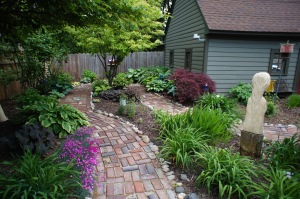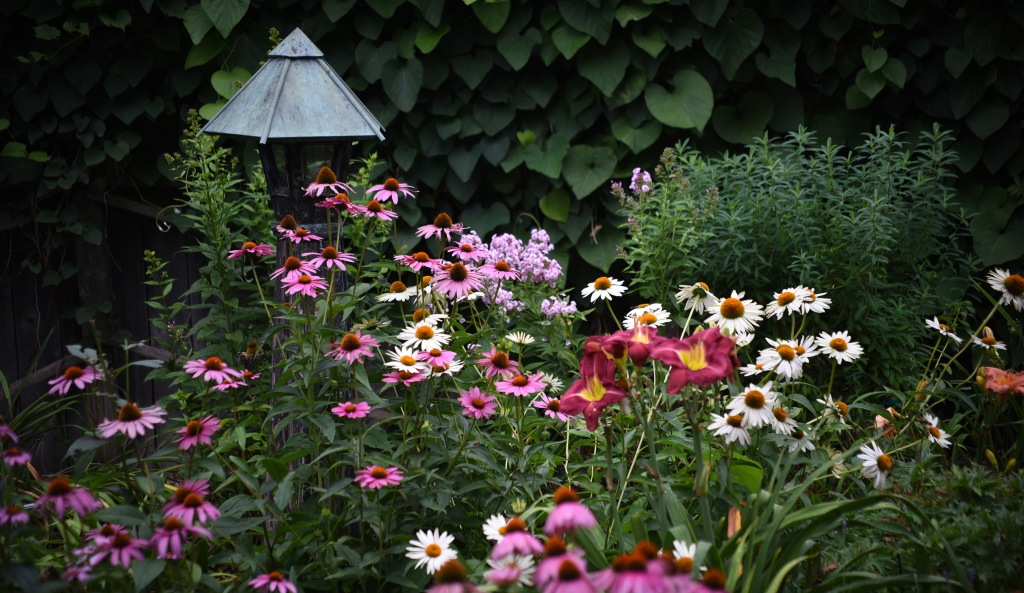

I think my goal, at least for my Secret Garden, has always been to create a country/cottage garden, but I’m not sure that’s quite what I’ve ended up with. I’ll let the reader be the judge. Initially, though, I was charmed by the IDEA of an English cottage garden, at least the romanticized version. And, of course, the book The Secret Garden had everything to do with my own version of that. I don’t have a rambling manor house or a hidden door or a mystical friend who helps me discover a garden that brings the world together in peace and harmony. I am, by the way, particularly charmed by the musical adaptation of the novel.
Some say that cottage gardens were first introduced in Great Britain by the Romans. Others say they arose after the Black Death which wiped out a third of the population in the British Isles. Laborers were few and former serfs found a demand for their work and the fruits of their labor. Rather than paying their rents in crops, serfs could pay a yearly rent, grow fruits and vegetables for their own use and to sell or trade. Some became skilled laborers who kept gardens.
Early cottage gardens were strictly utilitarian, becoming a source for fruits, vegetables, and scented plants that could be used for medicines, adding flavor to wines and ales, and for masking the unpleasant smells associated with being human in a time when there were no toilets or morning shower baths. This was especially important for those living in low-ceilinged thatched cottages that were dark and damp. These scented plants included peonies, pinks, hyssop, daylilies, Madonna lilies, and roses.

Those early cottage gardens were not planted with any attention to aesthetics. But that changed in the 16th century when trade with other regions brought new plants and ideas into the lives of cottagers and the landed gentry. It was the gentry that romanticized the cottage garden. Out went the concept of utility and in came the notion that cottage gardens were a type of planned abandon, a place to spend leisure time, and a way to show off one’s affluence. Tudor gardens borrowed from Italian gardens and included sun dials and statues.
It was the Victorian era that greatly influenced the modern cottage garden with its mass of flowers and a combination of “wild” and highly structured plantings. I suppose that describes my gardens, though I tend to think the “wild” aspect of my gardens comes from a lack of attention rather than a deliberateness. An hour ago I finally decided to tame the dutchman’s pipe that was taking over an arbor designated for clematis. As soon as I finish writing this, I’m going to go out again to pull weeds, plant, and take the pictures that appear here. I find that my blog posts go together better when I write the text and then insert the images. I tend to get overwhelmed by the wildness in my gardens and dither about where to start. I flit from one bed to another with no real plan. That perhaps is a result of my very associational brain. But there is also a sense of freedom there. I don’t have to do things in a logical order.

I noticed that the honey bees are awake and visiting the catmint. The bumble bees have been around for several weeks and I saw several carpenter bees, today, too. They look like bumbles but have shiny butts. Both bumbles and carpenters are excellent pollinators. And, unlike honey bees, bumbles and carpenters are native to North America.

So, is this a cottage garden? Is there enough wild abandon demonstrated, or is it too safe to be classified as a such. Scroll down for a few more pictures.
I am, by the way, looking forward to Garden Bloggers’ Fling in Toronto later this week. I anticipate getting lots of great ideas and experiencing other gardens just for the pure joy of it. This will be my first non-academic conference in decades!!

